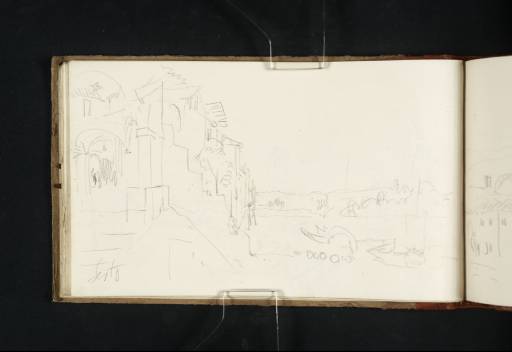Joseph Mallord William Turner View of Sesto Calende, Lake Maggiore 1819
Image 1 of 2
Joseph Mallord William Turner,
View of Sesto Calende, Lake Maggiore
1819
Joseph Mallord William Turner 1775–1851
Folio 13 Verso:
View of Sesto Calende, Lake Maggiore 1819
D14169
Turner Bequest CLXXIV 12 a
Turner Bequest CLXXIV 12 a
Pencil on white wove paper, 111 x 186 mm
Inscribed by the artist in pencil ‘Sesto’ bottom left
Accepted by the nation as part of the Turner Bequest 1856
References
1909
A.J. Finberg, A Complete Inventory of the Drawings of the Turner Bequest, London 1909, vol.I, p.508, as ‘Buildings near a river. “Sesto” (near Florence)’.
1930
A.J. Finberg, In Venice with Turner, London 1930, as ‘Sesto Calende, Lago Maggiore’.
2006
Federico Crimi, ‘J.M.W. Turner e il Verbano: Sulle vedute del porto d’Arona e dell’Isola Bella’, in Verbanus, no.27, 2006, p.180 note 8.
2007
Federico Crimi, ‘J.M.W. Turner e il Verbano: 1819: Torino, Milano e il Sempione’, in Verbanus, no.28, 2007, p.25 note 21.
As Turner’s inscription in the bottom left-hand corner indicates the subject of this sketch is a view of Sesto Calende, a town at the southern tip of Lake Maggiore where the River Ticino flows southwards towards the River Po. The artist passed through the area en route to Milan, following his tour around the Italian Lakes and the expedition into the Swiss Alps to see the Simplon Pass. Logically therefore the drawing should have been found at the end of the sketchbook, after the sketches of the ascent to Simplon, and indeed a further small study also inscribed ‘Sesto’ can be seen on the inside back cover of the sketchbook (D40889). However, the beginning of this book does contain a mixture of subjects which do not follow the geographical order of Turner’s travel itinerary. It is possible that Turner made arbitrary use of the first few sheets, regardless of the disruption this presented within the order of the pages. An alternative explanation would be that when the sketchbook was broken up during the nineteenth century,1 an error was made in numbering the leaves and the book was subsequently reassembled incorrectly. For further information about the physical order of the pages see the sketchbook introduction.
Finberg originally identified the sketch as depicting Sesto Fiorentino, near Florence.2 However, Federico Crimi has since confirmed that it is indeed a view of Sesto Calende.3 The composition spills over onto the opposite sheet of the double-page spread, see folio 14 (D14170; Turner Bequest CLXXIV 13). Turner’s viewpoint is the left (western) bank of the River Ticino looking north-west towards the opposite shore. The area was transformed during the late nineteenth century by the building of an iron railway bridge and the picturesque houses visible in the left-hand foreground were demolished as part of the formation of a new riverside embankment.
Nicola Moorby
January 2013
How to cite
Nicola Moorby, ‘View of Sesto Calende, Lake Maggiore 1819 by Joseph Mallord William Turner’, catalogue entry, January 2013, in David Blayney Brown (ed.), J.M.W. Turner: Sketchbooks, Drawings and Watercolours, Tate Research Publication, August 2013, https://www


